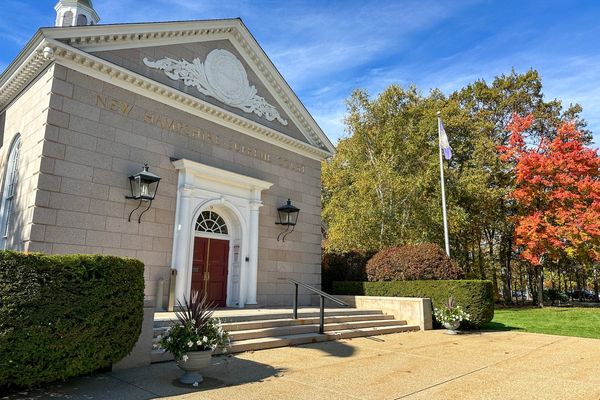It has been a while since theater productions targeting non-Japanese tourists started popping up one after another.
Theater production company Nelke Planning Co. joined the movement in September with "Kyoto Samurai Boys."
Nelke Planning made a name for itself by producing musicals mostly inspired by manga and anime, which are dubbed "2.5-dimensional musicals" because they bring characters from the two-dimensional worlds of manga and anime to the three-dimensional with live onstage performances. Those productions are very popular, particularly among young women.
It remains to be seen whether the company can make the most of the know-how it has gained from its past productions.
'Kyoto Samurai Boys'
Young men in costumes, which look like modernized samurai kimono, chant punchy lines fit for period drama characters. The audience responds to them by eagerly waving glow sticks. This was a scene from "Kyoto Samurai Boys," which opened Sept. 17 at a theater inside the premises of the Heian Jingu shrine in Kyoto. The show fascinates the audience with its staging full of traditional Japanese tastes.
"Many non-Japanese tourists visit Kyoto. We saw it as an opportunity. I hope this show will impress the audience with Japanese culture and the latest stage technologies," Nelke Planning chairman Makoto Matsuda said emphatically.
The show lasts about 40 minutes, an ideal duration for visitors to casually pop in and enjoy. The first 30 minutes of the two-part show is a nonverbal play with an easy-to-understand story about a group of young people who become trapped inside a smartphone game they were playing. They struggle and soon gain the spirits of samurai. The show boasts such state-of-the-art stage technologies as projection mapping and 3-D hologram images. The remaining 10 minutes is a music show with the cast members dancing to uptempo music.
"Kyoto Samurai Boys" employs various ideas and know-how accumulated from staging many "2.5-dimensional musical" productions. The shows take place at relatively small venues and have fascinated many fans by casting young actors playing manga and anime characters in fancy costumes and makeup.
The venue for "Kyoto Samurai Boys" has a seating capacity of 226. A walkway that runs at the back of the auditorium is so close to members of the audience that they can almost touch the actors.
The show is directed by Go Ueki, an internationally successful breakdancer. The 20 or so members of the all-male cast are in their 20s or younger and have been selected through auditions. They are divided into three training groups, and nine from the groups make it on stage in each performance.
"I believe there's definitely something you can convey to the audience beyond the language barrier," said actor Masamichi Satonaka, 25. "I want this show to be successful. I really feel like a samurai fighting hard."
According to the show's operator, the audience mostly consisted of young Japanese women in the beginning. Foreign people have been gradually increasing, and they seem to like the show. The company has received some good feedback, such as that the sword fighting is brilliant.
Trial and error approach
According to the Japan Tourism Agency, non-Japanese tourists spent about 4.5 trillion yen in 2018, renewing the record every year since 2012 when they spent about 1.1 trillion yen.
The movement to start theaters for foreign tourists has been ongoing, albeit with trial and error. So far, many such theaters have struggled to attract audiences.
In 2017, Studio Alta Co. started Alternative Theater in Yurakucho, Tokyo, although the company ended putting on its self-produced shows after about six months. Theater complex Cool Japan Park Osaka, which opened inside the Osaka Castle Park in Osaka in February, put on "Keren," a revue featuring traditional Japanese culture, which closed in August.
"It's true that samurai and ninja are popular worldwide, but it's not that you can attract non-Japanese people just by putting on a Japanese-style show in a simple, easy-to-understand way. You have to do proper market research on the show's subject themes, easy access, potential draws, and so on," said theater and film critic Hitomi Hagio.
Creating an attractive show
In the face of many struggling productions, the Kyoto-born nonverbal theater "Gear" is doing extremely well. The fantastic story depicts an encounter between the robots working at a former toy factory and the dolls that they manufacture. The production, which opened in 2012, reached the milestone of its 3,000th performance on Oct. 20.
"Attractive cities have attractive shows," producer Keito Kohara said. "I wanted to produce a show that any tourist can enjoy watching anytime, like the 'Blue Man Group' show in New York."
"To do so, you've got to produce a show that can convince Japanese audiences first," he added resolutely.
It was about three years after the show started that non-Japanese audience members started to increase at "Gear" performances. These days, they sometimes make up about 20 percent of the audience.
"I'd like to go on with my pursuit of creating a moving experience for people of all ages and nationalities in a long-term view. Suffice to say that my target audience are humans," Kohara said.
Read more from The Japan News at https://japannews.yomiuri.co.jp/







